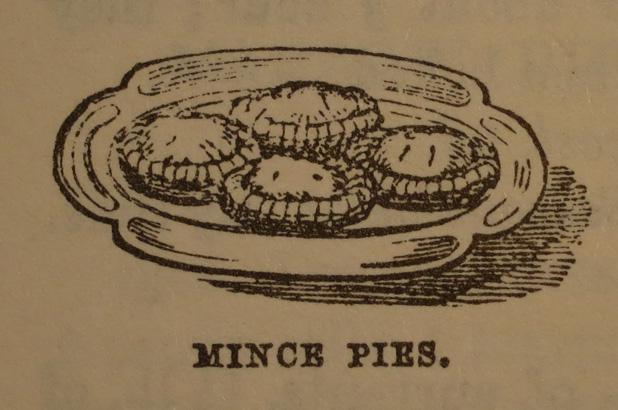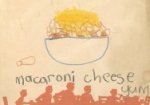Mince pies were exactly that; they were made with minced meat or, more traditionally, minced ‘neat’s’ (ox) tongue, enriched with spices and sweetened with dried fruit. Eliza Acton (1845) clearly had a preference for tongue – ‘boiled tender and cut free from the rind’ – in her ‘Mincemeat receipt’, nominating the ‘inside of roasted sirloin’ as an alternative.
‘Superlative Mincemeat’
Mrs Beeton (1861), however, asked for minced lean beef. Meatless mince recipes were around, with lemons as a key ingredient, but they still wouldn’t have pleased a vegetarian – they also called for beef suet. Eliza couldn’t help herself – in true carnivorous fashion, she closed her meatless but suet-rich ‘Superlative Mincemeat’ recipe with a note: ‘We think that the weight of one lemon in meat, improves the mixture’.
Not necessarily vegetarian…
The meat component slowly dropped away and ‘fruit mince’ has caught on as the accepted term for meatless (but not necessarily vegetarian) mince pies. Suet remained in mince pie recipes well into the second half of the 20th century. It’s still found in some fruit mince mixtures – especially in English brands (that’s what those little white stick-like bits are in Robertson’s jars) – but there are vegetarian versions around (check the ingredients label) or better still, make your own!
Maturing the mince
Mrs Beeton recommends the mince be made at the beginning of December; of course you can whip up a batch of fruit mince to use straight away, but it does improve with age. Discerning cooks make a batch each Christmas, but use the previous year’s supply to fill their pies. It’s a nice tradition to establish, and the fruit mince makes a good gift for friends. Top the maturing mince up every few months with brandy to ensure a rich moist result.
Fruit mince pies
Like the plum pudding, mince pies were an ideal treat for the northern hemisphere Christmas. Dried fruit was a logical option, as midwinter did not afford many fresh ingredients. Lemons and apples are consistently the only fresh fruit in mince pie recipes, as they would have still been available in the winter months. Every recipe author had their own version, but they all followed the same principles. I like Maria Rundell’s version (quoted below) for its low fuss simplicity, but you’ll notice I’ve added a splash of brandy and festive spices to my recipe.
Lemon Mince Pies
Squeeze a large lemon, boil the outside until tender enough to beat to a mash, add to it three large apples, chopped, and four ounces of suet, half a pound of currants, four ounces of sugar; put the juice of one lemon, and candied fruit, as for other pies. Make a short crust and fill the patty-pans as usual.
A New System of Domestic Cookery. Maria Rundell 1816.
Spice, the aroma of Christmas
Christmas not only has a flavour profile but, to me, an aroma that is just as important. Oranges have been associated with Christmas from a time when they were a luxury item imported from Spain. Classic spices, enjoyed since ancient times in festive food, are cloves (essential, albeit used sparingly), nutmeg and cinnamon. A good quality ‘mixed spice’ is a simple solution, or be adventurous and use the more robust French blend, quatre épice sweet (sweet four spice), available from specialty merchants such as Herbie’s Spices in Sydney.
Christmas fruit mince
Ingredients
- 1 large lemon (avoid using ones with thick skins )
- 3 crisp apples (eg Granny Smith or pink lady )
- 75g dried cranberries
- 1/2 cup finely granulated raw sugar
- 375g currants
- 75g dried mixed peel
- 1 tablespoon mixed spice
- 1/2 teaspoon ground cinnamon (preferably true cinnamon, not cassia)
- 1/4 cup brandy or rum (optional)
Note
This fruit mince is great for traditional mince pies. You can use either homemade or bought shortcrust pastry, but make sure you roll it fairly thinly. Alternatively, fold some of the mince through a good quality 'creamy' ice-cream for a lovely summertime dessert. Makes approximately 3 cups / 750ml fruit mince.
Directions
| Squeeze the juice from the lemon and pour it into a bowl. Reserve the 'shell', and discard the seeds. | |
| In a small saucepan, boil the lemon shell in enough water to cover it, for approximately 20 minutes, or until it is soft enough to mash to a pulp. Drain and allow to cool a little. If the lemon was thick-skinned, trim away some of the excess inner pith and discard. Mash or finely chop the shell. | |
| Peel the apple (discard the skin and core), then finely dice or coarsely grate the flesh. Chop the dried cranberries. Combine the apple and cranberry in a large bowl with the lemon juice, lemon pulp, sugar, currants, mixed peel, spices and brandy. | |
| Stir the mixture until all ingredients are well combined. Pack the fruit mince into sterile airtight jars and refrigerate. Leave for two weeks (or up to 12 months) to allow the flavours to meld. | |
| Cooks tip: If you are wondering why suet was used in the original 'receipts', it's because it gives a silky smoothness to the mince. You can add a little melted butter to the fruit mince before you fill your pies for extra richness if you like. This is not necessary if you are folding the mince through ice-cream. | |
Festive fruit mince ice-cream
Ingredients
- 2l good quality creamy vanilla ice-cream (low-fat ice-cream just won't do!)
- 300ml prepared fruit mince
- 1/2 cup fresh cream
- fresh berries (to serve)
Note
I make this as a summer version of Christmas pudding. It can be made several days in advance or the day before.
Directions
| Line a loaf tin with freezer film or use silicone moulds. Mini muffin moulds work well for individual serves. | |
| Put the ice-cream in the fridge for 20–30 minutes, or until it has softened just enough to work a spoon through. It is important that the ice-cream doesn't actually melt, and that it is returned to the freezer quickly. | |
| Using a spatula, fold the fruit mince and cream through the ice-cream until they are evenly distributed. Fill the loaf tin or moulds with the mixture. Tap the tin or moulds lightly on the kitchen bench to minimise air pockets, then closely cover the surface of the fruit mince ice-cream with freezer film. Put the tin or moulds in the freezer overnight, or until required. | |
| To serve, remove the freezer film and invert the ice-cream onto serving plate(s). If the ice-cream is reluctant to come out of the mould, lay a cloth dampened with warm water around the mould to help to release the contents. To serve, present the ice-cream(s) surrounded by assorted fresh berries. Slice the ice-cream as you might a cake or, for a more casual gathering, pass around finger-sized slices in small glasses topped with blueberries. | |
| The Cook's tip: pre-chill the serving plate(s) in the fridge or freezer for 10 minutes before plating up the ice-cream. | |

 Print recipe
Print recipe

